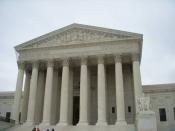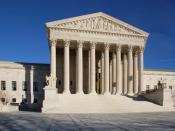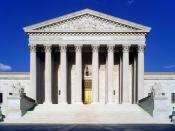By the middle of the 20th Century, the United States had emerged as a world power. It accomplished this through its leadership in defeating Germany and Japan in World War II. These two countries' main objective was to enslave the world and destroy political, religious, and economic freedom. In Germany or Japan, anyone who disagreed with these goals, or was different was destroyed. This was a common practice in these two fascist countries. Unfortunately, at the same time of its emergence as a world power, the United States began to slip into a form of judicial fascism. This slide began when the U.S. Supreme Court began to abandon the religious principles on which this nation was founded.
The abandonment officially began in 1947 in Everson v. Board of Education, when the court announced, "The 1st amendment has erected a wall between church and state. That wall must be kept high and impregnable.
We could not approve the slightest breach." (Barton, Original... p.13) This exact case began the reversal of Supreme Court trends and opinions that had lasted for one hundred and fifty years. Now, for almost fifty years, the Supreme Court , and the United States population in general, has used the phrase "separation of church and state" when referring to the religion clause of the 1st Amendment.
The 1st amendment's actual wording is "Congress shall make no law respecting an establishment of religion or prohibiting the free exercise thereof." (Barton, America: To... p.15) But, because of the Supreme Court's continuous citing of a "wall of separation" and "separation of church and state", the public's idea of the 1st amendment's religion clause has been shaped by phrases which do not appear anywhere in the Constitution. The First Congress, which passed this Amendment in 1789, intended to prohibit the...


